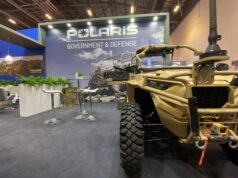NATO’s largest exercise in over a decade, involving 36,000 personnel from more than 30 Allied and Partner Nations.
The exercise is centred around certifying Headquarters Staff from Joint Force Command Brunssum to lead the NATO Response Force(NRF), if activated, throughout 2016. Trident Juncture(TJ) will also test elements of the U.K.-led Very High Readiness Joint Task Force (VJTF).
The NRF is NATO’s shock troops, a high-readiness and technologically advanced multinational brigade, comprising land, air, maritime, and special forces that NATO can use in any contingency that invokes Article 5. The VJTF is similar to the NRF, but is able to deploy in under 48 hours, making them NATO’S go-to Spearhead Force. This year’s certification exercise reflects a breakaway from counterinsurgency operations and moves towards combating the elements that comprise hybrid warfare that has been observed in the invasion of Crimea and Eastern Ukraine.
While the NRF is a brigade-sized force of 5–7,000 troops, Trident Juncture will have 36,000 servicemen involved, a realistic number to counter a similar contingency in the eastern Ukraine. The intent is for the NRF to grow to this number by 2018.
Even though the exercise is taking place in southern Europe, primarily Spain, Portugal, and Italy, invading a fictitious country called “SOROTA,” it is seen by many as reminding Russia that NATO is still a very capable alliance.
There is a large air component to the exercise, more than 140 aircraft from the Allies and Partners that are involved, including: Typhoon, Tornado, F-16, F-18, L-159, Mirage 2000, JAS-39 Gripen, MV-22 Osprey, C-130, C-160, Casa C-295 transport aircraft, air-to-air refuelling aircraft, dozens of helicopters, four early warning and control aircraft.
A large amount of naval assets will be involved as well, with subsidiary exercises in the Mediterranean, Atlantic, and the Black Sea, utilizing more than 60 ships and submarines.
There will be NGO’s and aid agencies participating from TJ’s inception. One interesting addition is defence firms are invited to observe and to formulate faster development of systems and weapons. This is a rare occurrence for an exercise of this scale.
As NATO starts to focus on countering contingencies, like the annexations that have occurred in territories of the Ukraine and Georgia, it is constructing new tactics for countering the dynamic elements that comprise Hybrid Warfare.
Hybrid warfare consists of cyber attacks, insertion of special forces into strategic positions, and propaganda campaigns, followed by conventional forces to seize key objectives. The tactics have proven to be tough to defend against, as evident in the Russian invasion of Georgian territories in 2008. Using the premise of defending Russian native speakers from “government oppression,” Russia has annexed massive chunks of land from sovereign nations. Now NATO is priming itself to defend against the possible use of hybrid warfare on one of its member states, primarily Lithuania, Latvia, and Estonia.
Combating this new, modern form of attack will be difficult, but NATO has already made huge strides in understanding how to effectively counter it- speed is everything. The quick deployment of combat ready troops and equipment is key. Special Forces must be able to secure strategic objectives from the enemy. It’s absolutely vital. These objectives could be as simple as police stations, court houses, government and political infrastructure, to more complex objectives, such as major railway distribution centres and airports. In a sense, when Russian Special Forces used locally trained militia to attack the aforementioned objectives, they hold the community hostage, installing puppet mayors and new “police” to control the local populace.
The NRF and VJTF aim to cut the head off of the snake before it gets its body through the door by barring the first phase of an attack and attempted seizure of critical objectives. The quick response shows the populace that their government is effective and willing to defend its people, inflicting a massive setback to the invading force. If the VJTV can have a sizeable force on the ground in the contingency area within 48 hours, it can have the potential to turn the tide, but would need large and quick reinforcements like the NRF to stop the subsequent invasion of conventional forces.
Trident Juncture commences the 28th of September, 2015, and, when it ends on the 6th of November, it will have certified the world’s premier unified fighting force. While no one currently thinks Russia wants “to fight us,” or as Lt. Gen. Robert Neller said “they don’t want to kill Americans,” they have expressed extreme rhetoric and demonstrated their willingness to use military force to annex chunks of sovereign nations. This time NATO, with the NRF and the VJTF, will be primed and ready.





